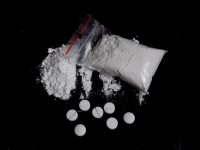Courts Show No Leniency Towards Drug Addicted Offenders

A recent case in Downing Centre District Court illustrates the way in which the courts deal with drug addicted people who commit crime to support their habit.
In R v Ligaiviu [2015], the offender’s addiction to crystal methamphetamine, or ‘ice’, was identified as a major contributing factor behind the offending conduct.
The judge in that case identified two ways in which ice addiction can lead to criminal conduct. The first is by causing paranoia or delusions which can lead to violence, and the second by creating a compulsion to acquire the drug through any means necessary.
R v Ligaiviu
The offender Steven Ligaiviu used 0.2grams of ice, which created a delusion that his estranged partner was having sex with his neighbours. He knocked on his neighbour’s door and yelled, “What’s going on, why is there screaming and shouting?”.
His neighbour answered and assured Ligaiviu that nothing was going on, to which Ligaiviu replied, “Don’t lie, I heard it all”, before returning to his unit.
Ligaiviu later returned to his neighbour’s unit carrying a kitchen knife, before knocking the door down and searching for his former partner whilst waiving the knife around in a threatening manner.
Ligaiviu ultimately left before police were called, and Ligaiviu was charged with aggravated break and enter with intent under section 111(2) of the Crimes Act 1900 (NSW), which carries a maximum penalty of 14 years.
In Court
Mr Ligaiviu pleaded guilty to that charge in Downing Centre District Court, where his sentencing proceedings came before Judge Berman.
In dealing with Ligaiviu, His Honour made it crystal clear that self-induced intoxication is not a ‘mitigating factor’ when it comes to determining the appropriate sentence – in other words, the fact that a person’s conduct was the result of being high on drugs does not lessen the penalty.
That conclusion is consistent with the way in which courts deal with self-induced intoxication generally – whether caused by alcohol, restricted substances, prohibited drugs or otherwise.
The Link between Ice and Crime
Media reporting about the link between ice and violent crime has been relentless over the past few years, leading to the establishment of a National Ice Taskforce.
The Taskforce released a report in 2013 estimating that a whopping 8.3% of Australians have been victims of at least one illicit drug-related incident.
However, a number of people including Associate Professor John Fitzgerald from the University of Melbourne believe that the impact ‘ice’ on society has been exaggerated – saying that “the ice pandemic’ is a myth” .
Fitzgerald rejects the idea that the supply and use of ice is on the rise, arguing that the increased police focus on detecting users is the reason behind the spike in arrests and prosecutions. Like many others, Fitzgerald believes that drug addiction should be treated as a health issue, rather than a legal one, and that arresting and prosecuting users does little to address the underlying issues that lead to drug addiction.
Whatever the case may be, it is clear that those who commit crimes while high on drugs can expect little by way of leniency – to the contrary, many feel that courts are increasingly expressing their frustrations about having to deal with people who commit violent crimes whilst intoxicated, and are sentencing offenders accordingly.






